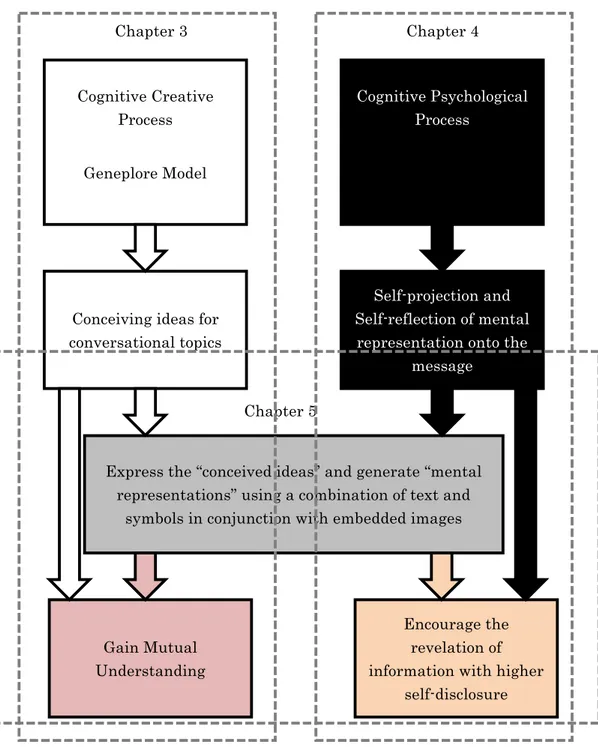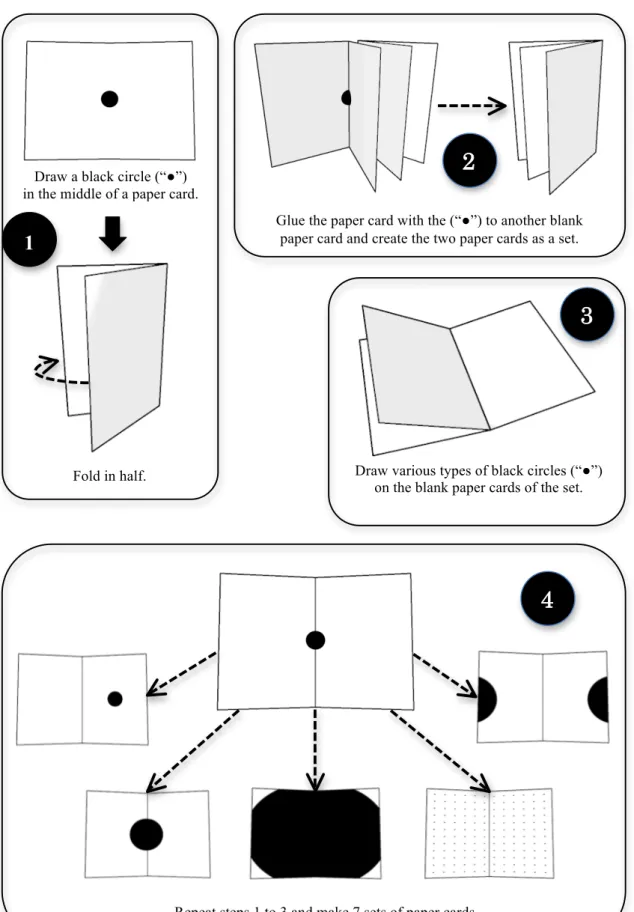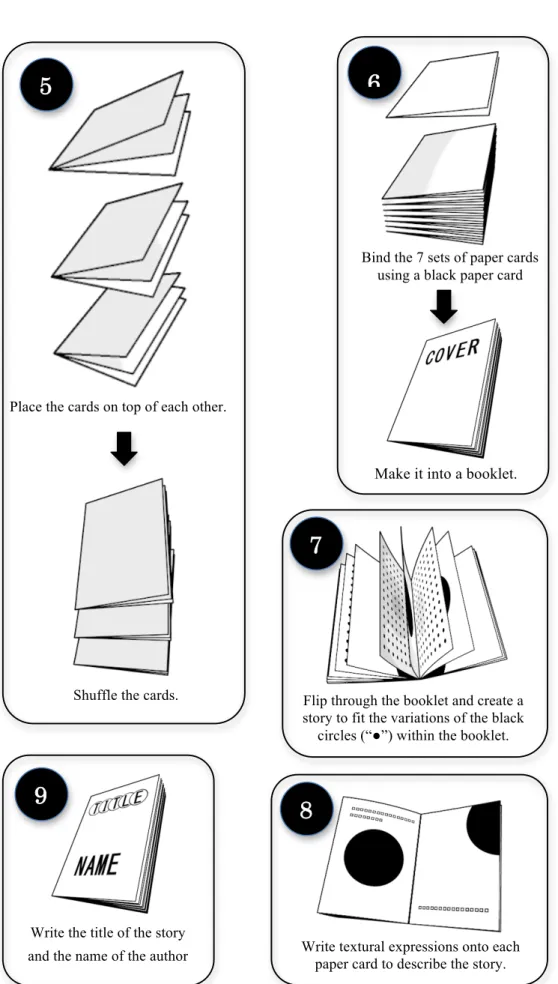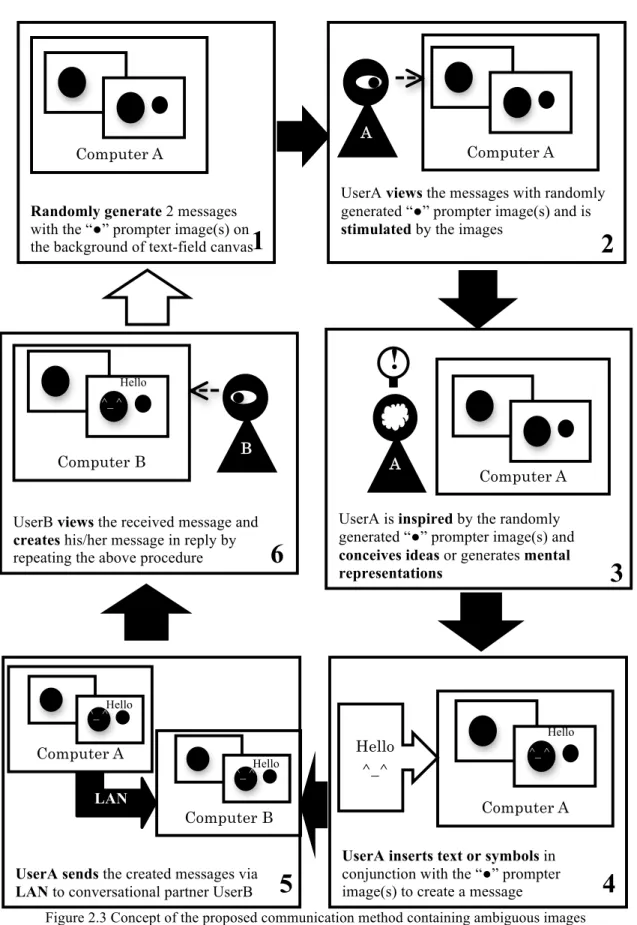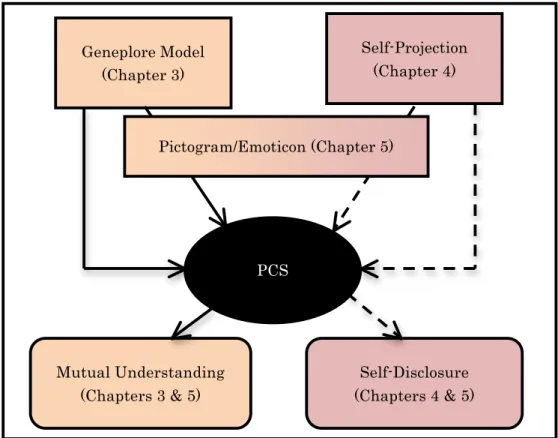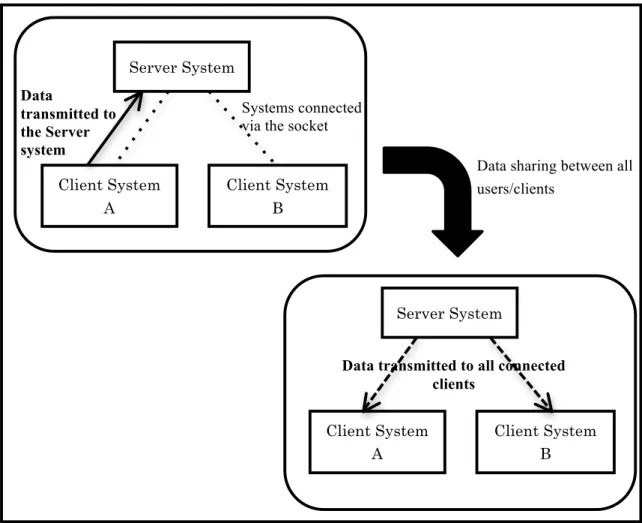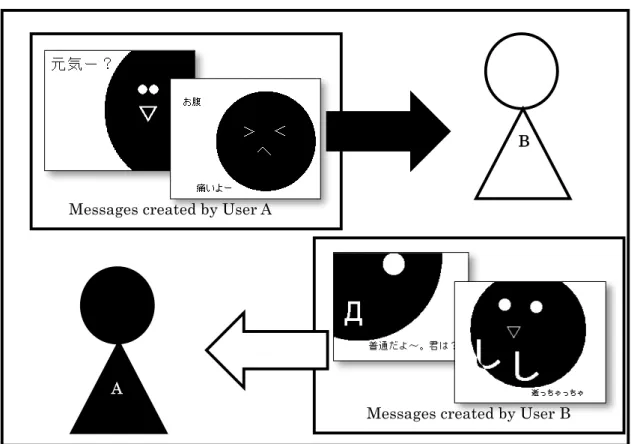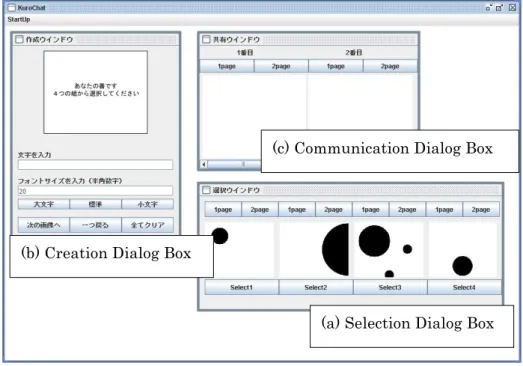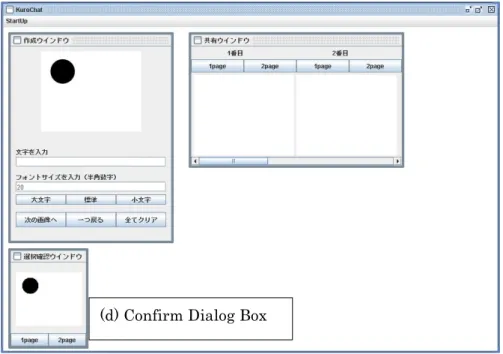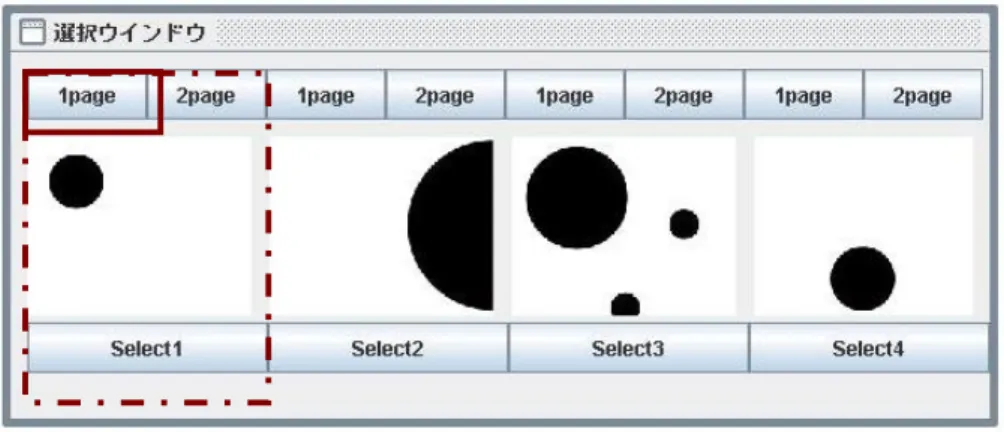Waseda University
Doctoral Dissertation
Research on Communication Means for Prompting
Mutual Understanding and Self-Disclosure
相互理解と自己開示を促進するコミュニケーション
手段に
関
する研究
January 2013
Graduate School of Global Information and Telecommunication Studies
Acknowledgements
This dissertation summarizes the achievements of my research at the Graduate School of Global Information and Telecommunication Studies (GITS), Waseda University, Japan, which would not have been possible without the contribution and support of a number of people. First and foremost, I would like to express my great acknowledgement to my supervisor, Prof. Jun OHYA for his invaluable advice and encouragement throughout these years. I would also like to convey my sincere gratitude and special thanks to Prof. Shigekazu SAKAI, Prof. Wataru KAMEYAMA and Prof. Shunichi YONEMURA for their supervision and review of my doctoral thesis. I am also grateful to them for kindly accepting to act as reviewers and judges for my doctoral thesis, as well as their helpful constructive advice. Moreover, I would like to give special thanks to Prof. Shigeru SHIMAMOTO, Prof. Yoshiyori URANO, Prof. Mitsuji MATSUMOTO, Prof. Yukio TOKUNAGA and Researcher Mutsumi SUGANUMA for their support and encouragement during my years at GITS, Waseda University.
I would also like to give thanks to all the GITS faculty members and staff who have helped me to remain on the correct path while conducting my research which has allowed me to achieve successful results. I am pleased to acknowledge all the members of the Ohya Laboratory, the Shimamoto Laboratory, the Sakai Laboratory and the Tokunaga Laboratory at the Shibaura Institute of Technology, especially to Jieun CHO, Jiang LIU, Khemry KHOURN, Mohamad Erick Ernawan and Pao SRIPRASERTSUK for their support and technical discussion.
I would like to deeply thank and give special appreciation to my wonderful family, my admirable parents, Yen-Lung CHEN and Chun-Hsiang WANG, my brother, Po-Chou (Jack) CHEN, my sister-in-law, Yi-Ting CHAN, my relatives, my family friends, and my homestay family for their continual encouragement, support and understanding.
Last, but not least, I would like to thank all of my friends, especially to Abduallah ALSHEHAB, David KELSEY, Yu-Tzu LIN, Wan-Yen (Nora) HSU, Chia Yu LIAO, Wan Chen TSAI and Hande UNLU, for their great support and endless encouragement throughout my doctorial years, which would not have been as enjoyable without having those good friends around.
Li Jen CHEN February 2013
Contents
Acknowledgements ... I List of Figures ... V List of Tables ... VII Summary ... IX
Chapter 1 Introduction ... 1
1.1 Background ... 1
1.2 Related Works ... 3
1.3 Purpose of the Research ... 6
1.4 Approach of the Research ... 6
1.5 Structure of the Dissertation ... 8
Chapter 2 Prompter Communication System ... 12
2.1 Motivation for the Research ... 12
2.2 Proposed Communication Means: Prompter Communication System ... 15
2.2.1 Conceptual Proposal of Prompter Communication System ... 15
2.2.2 Concept, Theory and Background ... 18
2.2.3 The Prototype Design of the PCS ... 20
2.3 Hypotheses ... 22
2.4 Prototype of The Prompter Communication System ... 23
2.4.1 The PCS Interfaces and Operational Procedures ... 24
2.5 Summary ... 30
Chapter 3 Prompting Mutual Understanding by Conceiving Conversational Topics ... 32
3.1 Introduction ... 32
3.2 Approach ... 33
3.3 Communication Experiments, Evaluations and Results ... 34
3.3.1 Participants ... 34
3.3.2 Method ... 34
3.3.3 Experimental Results ... 35
3.3.4 Discussion ... 39
3.4 Conclusion ... 44
Chapter 4 Prompting Self-Disclosure based on Self-projection and Self-reflection ... 47
4.1 Introduction ... 47
4.2 Approach ... 47
4.2.1 Concepts applied to the “●” prompter communication system ... 48
4.3 Experiments, Evaluation and Results ... 49
4.3.1 Purpose of the Experiments ... 49
4.3.2 Experimental Environment ... 49
4.3.4 Method ... 50
4.3.5 Experimental Results ... 51
4.3.6 Discussion ... 64
4.4 Conclusion ... 66
Chapter 5 Mutual Understanding and Self-Disclosure Using Pictorial-Text Expressions ... 69
5.1 Introduction ... 69
5.2 Concepts, Theory and Background ... 69
5.2.1 Concept and Background of Pictograms, Emoticons and Smileys ... 69
5.3 Approach ... 71
5.4 Experiments, Evaluations and Results ... 72
5.4.1 Participants ... 72
5.4.2 Method ... 73
5.4.3 Experimental Results ... 74
5.5 Conclusion ... 83
Chapter 6 Conclusions and Future Works ... 86
6.1 Conclusion ... 86
6.2 Future Works ... 88
Bibliography ... 92
List of Figures
Figure 1.1 The structure of this dissertation ... 10
Figure 2.1 The procedure for how to make an illustrated “●” picture book (part 1) ... 13
Figure 2.2 The procedure for how to make an illustrated “●” picture book (part 2) ... 14
Figure 2.3 Concept of the proposed communication method containing ambiguous images 17 Figure 2.4 The conceptual structure of the Geneplore Model ... 18
Figure 2.5 Conceptual Model of the PCS with the expected effects, together with the related Chapters ... 20
Figure 2.6 Configuration and relationships between the Server and Client Systems of the PCS ... 23
Figure 2.7 An example of the communication flow using the PCS ... 24
Figure 2.8 The initial interface of the PCS when launching the system ... 25
Figure 2.9 The PCS interface after the message set is selected from the (a) Selection Dialog Box ... 26
Figure 2.10 Selection Dialog Box of the Prompter Communication System ... 27
Figure 2.11 The Selection Dialog Box after clicking the “2page” button ... 28
Figure 2.12 The Creation Dialog Box of the PCS ... 28
Figure 2.13 The Communication Dialog Box of the PCS ... 29
Figure 2.14 The Confirm Dialog Box of the PCS ... 29
Figure 3.1 An example of a conversation using the PCS ... 37
Figure 3.2 An example of messages from the experiment using the PCS ... 38
Figure 3.3 The average frequency of the appearance of messages in each Category ... 38
Figure 3.4 A sample of the messages in each category obtained using the PCS ... 41
Figure 4.1 An example of the experimental results for a set of messages created by participants using the PCS ... 52
Figure 4.2 An example of the experimental results for a set of messages created by participants using the NCS ... 52
Figure 4.3 An example of the experimental results for different categories using the PCS ... 54
Figure 4.4 Average frequency of the appearance of messages in each Category using the PCS. Error bars indicate the Standard Error, SE. ... 55
Figure 4.5 Examples of experimental result messages categorized as Level 0 self-disclosure using both the PCS and the NCS ... 58
Figure 4.6 Examples of experimental result messages categorized as Level 4 self-disclosure using both the PCS and the NCS ... 59
Figure 4.7 The average frequency of the appearance of self-disclosure levels within experimental result messages between categories using the PCS. Error bars indicate the Standard Error, SE. ... 60 Figure 4.8 The average frequency of the appearance of self-disclosure levels within
bars indicate the Standard Error, SE. ... 62 Figure 5.1 An example of the communication flow created between participants using the
PCS ... 75 Figure 5.2 An example of the experimental results from a set of messages created by
participants using the PCS ... 76 Figure 5.3 An example of the experimental results from a set of messages created by
participants using the NCS ... 76 Figure 5.4 An example of the experimental results from a pictorial-text message and a
text-only message using the PCS ... 77 Figure 5.5 An example of the experimental results from a pictorial-text message and
text-only message using the NCS ... 78 Figure 5.6 Average frequency of the appearance of messages in pictorial-text style in
comparison with text-only style using both the PCS and the NCS. Error bars indicate the Standard Error, SE. ... 79 Figure 5.7 The average frequency of the appearance of self-disclosure levels within
experimental result messages between pictorial-text and text-only styles using the PCS. Error bars indicate the Standard Error, SE. ... 81 Figure 5.8 The average frequency of the appearance of self-disclosure levels within
experimental result messages between pictorial-text and text-only styles using the NCS. Error bars indicate the Standard Error, SE. ... 81 Figure 5.9 The average number of words in each message for each self-disclosure level for
List of Tables
Table 4.1 Definitions by Daibo et al and the equivalent altered definitions of self-disclosure levels and translations of the messages ... 57 Table 4.2 The average frequency of the appearance and standard deviations for each
self-disclosure level ... 60 Table 4.3 The average frequency of the appearance and standard deviations for each
Summary
Communication is one of the most important factors for encouraging and sustaining personal relationships between individuals. The rapid development of technology has provided us with numerous methods, styles and channels for communication, such as mobile phones, electronic mail, chat or Social Network Services (SNS). These new types of communication, known as Computer Mediated Communication (CMC), have attracted a great deal of attention and interest, especially with regard to relationship formation, such as gaining mutual understanding and its effect on revealing information with high self-disclosure.
Many theories and systems for supporting self-disclosure and gaining mutual understanding in order to further lead to the development of intimate relationships through CMC have been proposed. These studies have confirmed that each of these systems is able to assist users in communicating with others with a higher level of inner self-expression or self-disclosure. However, telecommunication users may not have common knowledge and/or topics, and/or do not share one common space. This causes difficulties in continuing the conversation; therefore, mutual understanding is not deepened. In the case of existing telecommunication systems, the lack of the ability to pre-select emoticons and pictographs that can be used to express the user’s emotions or feelings could cause difficulties in encouraging self-disclosure by users; similarly, the constraints of actions and expressions of virtual agents and the virtual medium could also raise self-disclosure concerns. These issues are mainly caused by the fact that “beyond greeting level” conversation and/or full and free expressions of emotions or actions are virtually impossible.
This dissertation proposes a new communication means that is aimed at encouraging mutual understanding and self-disclosure between remote telecommunication users. The proposed communication method, which is motivated by Hasegawa’s manual operation-based technique for creating stories for fairy tales, randomly generates visual images that include black circle(s) called prompter(s) embedded on the background of a text-field canvas. More specifically, the proposed communication method, which is
called the Prompter Communication System (PCS) in the following, allows a participant to freely insert text or symbols and drag them to the desired position(s) on the text-field canvas so that a message is created in conjunction with the randomly generated visual image(s). Then, the participant sends the created message to his/her telecommunication partner via the network. As soon as the partner receives and views the message, another random visual image containing prompter(s) is generated for the partner. Using the generated image, the partner creates a message in reply using the above-mentioned procedure and sends it to the first participant. This process is then repeated to continue the conversation.
The PCS is considered to be modeled on the concepts of the Geneplore model, which describes the cognitive process of creative thinking, because the PCS is founded on the story creation process and is a communication means by which users construct messages based on new creative ideas prompted by the received message. In addition, the process for creating a prompter message can be modeled as a reflection or projection of the user’s mental representations. Consequently, by considering these models that describe the PCS, this thesis generates the following hypotheses to be verified:
(1) Based on the Geneplore model, the PCS can prompt users to create new topics
for conversation and/or to frequently change from one topic to another so that mutual understanding between participants can be deepened.
(2) Based on the properties of the projection and reflection of mental
representation, the PCS can encourage users to disclose more information about themselves: i.e., self-disclosure can be enhanced by using the PCS.
(3) Based on both the Geneplore model and the projection/reflection theory, users
can create and express conceived ideas and generate mental representations by combining prompter(s) and text/symbols so that both mutual understanding and self-disclosure can be promoted.
The verification of these hypotheses by this thesis is described as follows.
Chapter 1 is the Introduction, which consists of the background, the related work, the purpose, the proposed approach and the organization of this thesis.
describe the PCS are explained, and an illustration of the implementation of the PCS is provided.
Chapter 3 explores whether hypothesis (1) can be verified. From the concepts developed by the Genelplore model, the PCS could prompt conversational topics and/or informal communication by telecommunication users; in addition, the PCS could foster the conception and switching of conversational topics during telecommunication sessions. Communication experiments using the prototype of the PCS were conducted. The experimental results suggest that the PCS encourages the conception of topics that are strongly related to conversations, such as discussions about the current situation related to either or both of the participants, inner feelings and thoughts combined with shared knowledge. Furthermore, an effect on deepening mutual understanding between the participants is confirmed.
Chapter 4 explores hypothesis (2). Founded on the projection/reflection theories, the PCS could influence users to associate ambiguous figures, such as the prompter image(s), with mental representations generated based on self-projection or self-reflection. This property could encourage users to reveal information with high self-disclosure during conversations. Communication experiments using the PCS and a comparison system, the Normal Communication System (NCS), which is implemented using only a plain text-field canvas without the prompter image(s), have been conducted. Experimental results indicate that communication conducted using the PCS results in an increased number of messages with the prompter images involved as part of the message contents rather than as background images. Further analysis into the self-disclosure level of the message contents and the relationships between the degree of self-disclosure and the representations of the prompter image(s) within the messages indicates that the degree of self-disclosure increases when the prompter images are used to represent the participant him/herself, or the participants thoughts and emotions, and decreases when the prompter images are used to represent animals or objects, or when the prompter images presented within the messages are ignored. Investigations into differences in self-disclosure level between message contents from the PCS and the NCS show that the PCS results in generally higher degrees in the average frequency of the appearance of high self-disclosure information than the NCS.
Chapter 5 explores hypothesis (3). Based on both the Genelore model and the projection/reflection theories, the PCS could support and encourage pictorial-text style communication by participants using text and symbols in conjunction with the prompter image(s), to compensate for the lack of non-verbal information and to improve emotional and visual expression. Experiments designed to explore the ability of the PCS to support non-verbal expression by encouraging the creation of pictogram-like, pictorial-text messages are conducted. It is observed that the PCS is able to enhance and enrich the user experience and encourage participants to express their thoughts, feelings and emotions in a pictorial-text style, thereby mitigating the lack of emotional and visual expression in plain text messages, which is an essential element for both intimacy and the development of deep interpersonal relationships. Communication experiments that compare the PCS with the NCS are conducted. The experimental results indicate that the PCS encourages a larger number of messages based on the pictorial-text style than the NCS.
Chapter 1
Introduction
1.1
Background
Communication is one of the most important factors for encouraging and sustaining personal relationships between individuals. The rapid development of technology has provided us with numerous methods, styles and channels for communication, such as mobile phones, electronic mail, chat or Social Network Services (SNS). These new types of media allow individuals to release, share, access, and interact with each other much more easily than in earlier times. However, at the same time, they prevent individuals from gaining information other than what is consciously released and shared [1], and the lack of non-verbal expression and the information shared during communication where a physical presence exists, such as emotional expressions and gestures, and information with high self-disclosure, have raised concerns [2].
A number of studies have indicated that computer-mediated communication (CMC), with its inherent anonymity, provides a shell for an individual to reveal his or her true self through private information and emotions without a sense of anxiety. Other research has presented alternative observations and has indicated that such a shell helps the individual to disguise or hide his/her true self. Several investigations into communication have indicated that certain individuals still find it difficult to reveal information with high self-disclosure and gain mutual understanding with others. This information includes the inner thoughts, emotions, problems and difficulties related to the individual, lack of knowledge sharing and collaboration, which result in a failure to initiate the development of intimate and deep interpersonal relationships with others [3][4].
There have been several studies indicating that, regardless of the communication media and methods, intimate and deep interpersonal relationships result from communications with high self-disclosure [5][6] and mutual understanding between
individuals. Self-disclosure is defined as the act of revealing more about oneself to others, including thoughts, feelings, aspirations, and fears, as well as one’s likes, dislikes and favorites, etc. [6][7]. This basic self-disclosure usually occurs early in the development of the relationship, thereby forming the initial impression between individuals [8], but more intimate self-disclosure is usually observed later in the relationship [9][10]. Mutual understanding presupposes a common ground consisting of shared information, mutual knowledge, mutual beliefs, and mutual assumptions [51]. In the process of grounding this information and knowledge, conversation participants seek positive evidence of understanding via external sources such as feedback, acknowledgement through back-channel responses, continued attention, and the initiation of the relevant “next turn” in the conversation [52]. The relevant “next turns” can be produced in all kinds of media, whereas back-channel responses and signaling continued attention, such as eye gazing, require a form of co-presence similar to face-to-face communication [53]. However, it is very difficult to measure and determine whether or not mutual understanding has been achieved, therefore, the degree of revelation of personal information or self-disclosure might be seen as a parameter for determining the observable mutual understanding, since mutual understanding would not be possible to achieve without revealing personal information or self-disclosure. According to this assumption, the greater the revelation of personal information or self-disclosure, the higher the possibility of mutual understanding that can be obtained.
As online social interaction and communication have become a pervasive phenomenon, CMC has attracted a great deal of attention and interest with regard to relationship formation and its effect on self-disclosure. These studies have routinely investigated communication undertaken founded on CMC settings in comparison with face-to-face settings, or with video conferencing settings, and have have indicated that CMC communication settings generate information with a similar or higher self-disclosure level than those of face-to-face settings and video conferencing [1][11]. Although there have been many studies into the effects of CMCs on encouraging mutual understanding and self-disclosure in a text-based environment in order to encourage the further development of intimate and deep personal relationships, studies using stimuli to inspire the conception of conversational topics and promote the projection and expression of mental representations using a combination of text and symbols in order
to encourage mutual understanding and reveal information with higher self-disclosure, are rarely found.
The definition of prompting is the action of saying or doing something to persuade, encourage, or remind someone to do or say something in response [61]. However, the essence of the prompting portrayed in this research is closer to the concept of stimulating, persuading, inducing, promoting or encouraging someone to conceive ideas, conversational topics, or stories, either consciously or unconsciously, in order to share or reveal knowledge and information about oneself, and support the aim of this research so as to encourage higher self-disclosure and promote mutual understanding. The prompting method using the ambiguous image(s) is aimed at removing cognitive constraints, such as, for example, a yellow circle is easily associated with the moon or the sun, and allowing users to conceive, imagine, project or reflect their ideas or mental representations more purely, without cognitive distractions, when creating messages in order to fully express their imagination, messages or themselves. By sharing such information, images or messages, users may gain more information about each other, and at the same time, may also be able to discover more about themselves, which leads to better or deeper relationships between individuals.
1.2
Related Works
Many theories and systems for supporting self-disclosure and gaining mutual understanding in order to further lead to the development of intimate relationships through CMC have been proposed. Several studies have proposed systems that use visual cues, such as virtual agents, Virtual Reality and photographs, to share virtual presence, co-presence, social presence and self-awareness in a virtual environment. Each of these systems aim to compensate for physical absence and foster higher self-disclosure or discourse [11-13]. Other studies have proposed systems that provide emotional icons or pictographs to convey social emotions and increase non-verbal information exchanges. These systems are aimed at reducing the perception of hostile or insulting interactions in text-based CMC, and offer a richer sense of expression and communication [14]. Additional studies have provided a selection of pictograms or visual symbols that can be implemented by users with language differences, disabilities
or handicaps in order to minimize hardship or boundaries when communicating [15]. Other studies have provided text-based web surveys or forums in order to promote communication with higher self-disclosure information and to increase the level of intimacy for interpersonal relationships [16].
These studies have confirmed that each of the systems mentioned are able to assist users in communicating with others with a higher level of inner self-expression or self-disclosure. However, the limitations and constraints of the systems, such as a lack of the ability to pre-select emoticons and pictographs, or constraints on the actions and expressions of virtual agents and the virtual medium could also raise concerns. These issues are mainly related to the concept of not being able to fully and freely express emotions or actions.
From 1960 to 1970, human-machine interaction systems, such as ELIZA, were quite famous and well known. ELIZA was a computer program that was an early example of primitive natural language processing. ELIZA was operated by processing user responses to scripts, and was implemented using simple pattern matching techniques [54]. Although ELIZA had an effect on inducing users to prompt conversation, it was one of the first chatterbots aimed at human-machine interaction in the artificial intelligence arena rather than aimed at prompting users for ideas for conversational topics.
Research into prompting users for ideas for conversations is very limited. As mentioned in the dissertation, that research usually provides a system that allows users to co-exist or physically represent themselves, using avatars or images, etc., as if they are in the same room or in a virtual space in order to encourage the formation of informal communication [55], or provides images and/or topics, etc., to prompt users to discuss or share information in order to encourage informal communication [56]. The most well-known techniques used as prompting methods, so-called response prompting procedures [57], have often been used for teaching chained tasks to infants and adults with mild to profound intellectual disabilities, autism or developmental delays. Response prompting techniques are systematic strategies used to increase the probability of correct responses, and as opportunities for positive reinforcement for learners by providing and then systematically removing prompts. The goal of response
prompting is to transfer stimulus control from the prompt to the desired discriminative stimulus and is quite different to the purpose of this research, which is to prompt ideas for conversational topics.
Other research related to prompting covers issues such as writing skills training where the aim is to support the process of writing rather than the input of the contents, and these methods prompt the trainee when necessary by referring to a flowchart or a help sheet, or to explanations, such as encouraging the trainee to think of a good word to use or have a good idea to write [58]. Other research, such as providing topics, themes, unfinished sentences or phrases, allow users to complete and create their own story using their imagination, or to apply the divergent thinking method that combines or integrates the inserted words, or to support and group the relevant words together and try to generate new ideas based on those words [59-60]. Those methods provide clear support for the user to achieve their goals, while, at the same time, restricting them from thinking freely without constraints.
In semiotics, a sign is something that can be interpreted as having a meaning, and is therefore able to communicate the information by interpreting or decoding the sign between individuals. A symbol is something that represents an idea, a process, or a physical entity and its purpose is to communicate a meaning, such as a red octagon may be referred to as “stop”. Whereas, a pictogram or pictograph is an ideogram that conveys its meaning through its pictorial resemblance to a physical object. Pictographs are often used in writing and graphic systems in which the characters are, to a considerable extent, pictorial in appearance and can be seen as a form of writing which uses representational, pictorial drawings.
Early written symbols were based on pictographs (pictures which resemble what they signify) and ideograms (symbols which represent ideas). Ancient Sumerian, Egyptian, and Chinese civilizations began to use such symbols over time, developing them into logographic writing systems. While developing them into these systems, meanings regarding the symbol have been constrained and limited to avoid ambiguity and confusion, which, at the same time, also diminished the richness and depth of its meaning and expression. This may seem to be one of the reasons for the lack of nonverbal expressions in text-based communication. The proposed communication
method is the opposite in comparison to the usual sign/symbolic communication methods, where the ambiguity is an essential element or feature of the method/system. The ambiguity of the provided medium allows users to imagine, create, express and transmit information that conveys more than verbal expressions in order to gain better understanding between individuals.
1.3
Purpose of the Research
Based on these notions, the purpose of this research is to propose a new communication method and a prototype text-based CMC system that is aimed at:
・ Supporting the deepening of mutual understanding during informal
communications
・ Encouraging the revelation of information of higher self-disclosure between users
An investigation into and an evaluation of the proposed method and its ability to support mutual understanding and self-disclosure, as well as its effects, have been conducted.
1.4
Approach of the Research
In this dissertation, a new communication means aimed at encouraging mutual understanding and self-disclosure between remote users is proposed. The proposed communication method, which is motivated by Hasegawa’s manual operation-based technique for creating stories for fairy tales [17], was designed founded on the concepts of the Geneplore model [18], and integrated with the features of emoticons and pictograms [2], together with the notions of self-projection and self-reflection [19]. The main functional characteristic of the method is that it includes one to three black circular prompter images (“●”), referred to as “●” prompter image(s) in the following, are
randomly embedded on the background of a text-field canvas. The “●” prompter
image(s) represent an ambiguous figure which motivates the participants to use their
imagination and turn the “●” prompter image(s) into any form, object, or emotion, etc.,
him/herself and places limits on users in their imagination or creativity. More specifically, the proposed communication method allows participants to freely insert text or symbols and position them by dragging and dropping them to the desired position on the text-field canvas, thereby creating messages in conjunction with the
randomly embedded “●” prompter image(s). After the creation is complete, participants
send the messages to their conversation partner via the network. The conversational partner views the received messages, and then creates his/her message in reply using the same procedure and returns it to the participant in order to continue the conversation. The PCS is considered to be modeled on the concepts of the Geneplore Model, which describes the cognitive process of creative thinking, because the PCS is founded on the story creation process and is a communication means by which the users construct messages based on new creative ideas prompted by the received message. In addition, the process for creating a prompter image message can be modeled as a reflection or projection of the user’s mental representations. Consequently, by considering these models that describe the PCS, this thesis generates the following hypotheses to be verified.
(1) Based on the Geneplore model, the PCS can prompt users to create new topics
for conversation and/or to frequently change from one topic to another so that mutual understanding between telecommunication users can be deepened. (2) Based on the PCS’s properties of the projection and reflection of mental
representation, the PCS can encourage users to disclose more information about themselves: i.e., self-disclosures can be enhanced by using the PCS.
(3) Based on both the Geneplore model and the projection/reflection theory, users
can create and express new representations by combining prompter(s) and text/symbols so that both mutual understanding and self-disclosure can be promoted.
These hypotheses have been verified and investigated through subjective evaluation experiments conducted using the proposed prototype system, the PCS, and a psychological analysis performed with the degree of self-disclosure level used as the measurement parameter.
1.5
Structure of the Dissertation
The structure of this dissertation is shown in Fig. 1.1, and the remainder of this dissertation is organized as follows:
Chapter 1 is the Introduction, and consists of the background, the related work, the purpose, the proposed approach and the structure of this thesis.
In Chapter 2, the motivation for the research, the concepts and theories of the proposed communication method, the models and theories of the PCS, the hypotheses generated by the models and theories, the details of the PCS used for verifying the hypotheses, and the implementation details of the PCS are introduced and explained. Chapter 3 explores whether hypothesis (1) can be verified. This chapter introduces and evaluates the ability of the PCS to promote the conception of conversational topics by participants and encourage mutual understanding in order to support informal communication between distant users. The PCS is designed based on the concept of the Geneplore Model, and its basic functions are intended to foster the conception and switching of conversational topics during informal communication. Communication experiments using the prototype PCS have been conducted and are described in detail with the evaluated results and discussions related to mutual understanding.
Chapter 4 explores hypothesis (2), and introduces and evaluates the PCS for supporting the self-projection or self-reflection of generated mental representations onto
the “●” prompter image(s) in order to encourage the revelation of information with high
self-disclosure during communications. Communication experiments using the PCS and the comparison system, the Normal Communication System (NCS), are conducted. The experimental results are categorized for further analysis using the degree of self-disclosure level as the measurement parameter. The details of the statistical evaluation results are described and discussed in reference to self-disclosure.
Chapter 5 explores hypothesis (3), and introduces and evaluates the PCS for supporting and encouraging communication using a combination of text and symbols in conjunction with the “●” prompter image(s) in a pictorial-text style so as to compensate for missing non-verbal information, and to improve emotional and visual expression
during text-based conversation in order to encourage mutual understanding and higher self-disclosure. The ability to support non-verbal expression by encouraging the creation of pictogram-like, pictorial-text messages is examined. The experimental results are categorized into pictorial-text style or text-only style and further investigation into the degree of self-disclosure for both styles is conducted and described in detail with regard to mutual understanding and self-disclosure.
In Chapter 6, the conclusion to the dissertation is provided and potential future works are discussed.
Figure 1.1 The structure of this dissertation Cognitive Creative Process Cognitive Psychological Process
Conceiving ideas for conversational topics
Self-projection and Self-reflection of mental
representation onto the message
Express the “conceived ideas” and generate “mental representations” using a combination of text and
symbols in conjunction with embedded images
Gain Mutual Understanding
Encourage the revelation of information with higher
self-disclosure
Geneplore Model Self-Projection
Chapter 3 Chapter 4
Chapter 2
Prompter Communication System
2.1
Motivation for the Research
The foundation and motivation for the research into the proposed method was originally inspired by a Japanese book entitled “Ehon-Zukuri (Picture/illustrated book making) Training”, by S. Hasegawa [17]. Among the methods proposed by S. Hasegawa, the
method of making the ““●” Obento (Lunch box) Picture/illustrated Book” has inspired
and motivated us to apply the motif and features into text-based CMC methods. The procedure for making the “Obento Picture/illustrated Book” is shown in Fig. 2.1 and Fig. 2.2, an example of which is as follows:
1. Draw a black circle (“●”) in the middle of a paper card.
2. Glue the paper card with the black circle to another blank paper card and create
the two paper cards as a set.
3. Draw various types of black circles on the blank paper cards of the set.
4. Repeats steps 1 to 3 and make 7 sets of paper cards.
5. Shuffle and exchange the paper cards with friends so as to randomize the order
of the paper cards.
6. Bind the 7 sets of paper cards with a black paper card and make it into a booklet.
7. Flip through the booklet, and create a story that fits the variations of the black
circles within the booklet.
8. Write textural expressions onto each paper cards to describe the story.
9. Write the title of the story and the name of the author on the cover of the booklet.
Figure 2.1 The procedure for how to make an illustrated “●” picture book (part 1) Draw a black circle (“●”)
in the middle of a paper card.
Fold in half.
1
Glue the paper card with the (“●”) to another blank paper card and create the two paper cards as a set.
2
Draw various types of black circles (“●”) on the blank paper cards of the set.
3
Repeat steps 1 to 3 and make 7 sets of paper cards.
Figure 2.2 The procedure for how to make an illustrated “●” picture book (part 2) Place the cards on top of each other.
Shuffle the cards.
5
Bind the 7 sets of paper cards using a black paper card
Make it into a booklet.
6
Flip through the booklet and create a story to fit the variations of the black
circles (“●”) within the booklet.
7
Write textural expressions onto each paper card to describe the story.
8
Write the title of the story and the name of the author
on the cover of the booklet.
There are two important features mentioned in the book: the “contingency/fortuitous” aspect, and the “turn-over-the-page effects” aspect, which stimulate the unexpected or
undiscovered creativity/imagination of the viewers.The “contingency/fortuitous” aspect
of the black circles resulting from shuffling and exchanging the paper cards may be the visual stimulus that inspires the viewer to create a story beyond their own imagination. The “turn-over-the-page effects” aspect is similar to the “montage” technique used in film editing, in which a series of short shots are edited into a sequence to condense space, time and information [20]. As the viewer moves through the pages, the black circles appear on the pages in different sizes, positions and number as a condensed sequence of information. The information lacking within the condensed sequence is compensated for by the imagination of the viewer, which, as a consequence, may stimulate and train the ability of creativity
2.2
Proposed Communication Means: Prompter
Communication System
2.2.1
Conceptual Proposal of Prompter Communication System
The suggestion of using black circle as motifs and create picture/illustrated book and the features mentioned above has inspired and motivated the authors to propose a new communication method aimed at promoting the initiation of conversations and mental representations that reveal inner thoughts and feelings using ambiguous images/shapes as the motif/stimuli for text-based CMC techniques.
The shapes of the ambiguous images embedded on the background of the text-field canvas were chosen based on preliminary experiments conducted beforehand. The author et al. made a comparison between the shapes, such as a square or a triangle, etc., and the use of different colors for a variety of ambiguous figures, and the results suggested that a black circle, referred to as the “●” prompter image(s) in the following, having sufficient ambiguity to allow participants to represent it as any form, object, or emotion, was the most appropriate design that could be used as the stimuli and as the
embryonic basis for creating messages [18]. The “●” prompter image(s) that appears
positioned using a random variable with an occurrence frequency of 1 to 3 “●” prompter image(s) and a canvas coverage rate (the ratio of the area of the background and the prompter) of less than 60% per message, which was determined to be the ideal number of prompter images and most suitable coverage rate required for users to create messages, as indicated from the preliminary experimental results [18].
The concept of the proposed communication method is as follows, as shown in Fig. 2.3.
1. The system randomly generates the “●” prompter image(s) on the background
of the text-field canvas as stimuli.
2. UserA views the randomly generated “●” prompter image(s) and is stimulated
by the images.
3. UserA is inspired by the randomly generated “●” prompter image(s) and
conceives ideas or mental representations.
4. UserA inserts text and symbols and creates a message in conjunction with the
“●” prompter image(s).
5. UserA sends the created message to UserB via the network.
6. UserB views the received message and creates his/her own message by
Figure 2.3 Concept of the proposed communication method containing ambiguous images Randomly generate 2 messages
with the “●” prompter image(s) on the background of text-field canvas
Computer A
UserA views the messages with randomly generated “●” prompter image(s) and is
stimulated by the images
Computer A
A
UserA is inspired by the randomly generated “●” prompter image(s) and
conceives ideas or generates mental representations
Computer A
A
!
UserA inserts text or symbols in conjunction with the “●” prompter image(s) to create a message
Computer A Hello
^_^
Hello
^_ ^
UserA sends the created messages via
LAN to conversational partner UserB Computer A Hello ^_ ^ Computer B Hello ^_ ^ LAN
UserB views the received message and
creates his/her message in reply by repeating the above procedure
B Computer B Hello ^_ ^
3
4
5
1
2
6
2.2.2
Concept, Theory and Background
As illustrated in Fig. 2.4, the PCS can be considered as being founded on the Geneplore Model, which was first introduced by Finke et al. in 1992 [18]. The aim of the Geneplore model was to delineate the cognitive processes involved in domain-independent creative activities. According to the Geneplore model, creative activity is the process of generating, exploring, refining, and then regenerating mental representations in the service of task demands and goals.
Figure 2.4 The conceptual structure of the Geneplore Model
The Geneplore model, as shown in Fig. 2.4, involves two major types of cognitive processes: a generative process and an exploratory process. The cognitive process constructs initial mental representations in an incomplete form, known as preinventive structures, and the exploratory process interprets the preinventive structures in meaningful ways, which are then modified to satisfy the specific goals of the task [21]. The Geneplore model also specifies that there are constraints on the form and function of the creative products that arise from the specific nature of the task or the generative processes involved. These constraints demonstrate additional regularities in cognitive
Generation of Preinventive Structures Preinventive Exploration and Interpretation Products Constraint Focus or Expand Concept
processing insofar as they focus generative processing on retaining certain domains of information as well as discarding or abandoning others [21].
The proposed system is also integrated with the concepts of self-projection that allow users to project and reflect their mental representations onto the provided ambiguous images, in order to encourage the revelation of inner thoughts and feelings during communication. Self-projection is a psychological defense mechanism where a person subconsciously denies his or her own attributes, thoughts and emotions, which are then ascribed to the outside world, usually to other people, but sometimes to animals or inanimate objects, etc. [19]. Thus, self-projection involves imagining or projecting the belief that others originate those feelings and thoughts, and reduces anxiety by allowing the expression of unwanted unconscious impulses or desires without allowing the conscious mind to recognize them. Self-projective assessments are based on the theory that the individual projects things of him/herself onto everything he/she does, either consciously or unconsciously. Thus, those assessments have often been used for personality assessments that are designed to encourage an individual to respond to ambiguous stimuli, presumably revealing hidden emotions and internal conflicts, thereby reducing resistance and anxiety when revealing high self-disclosure information [22][23]. The revealed inner thoughts and high self-disclosure information will not only help a psychologist to understand the individuals concerned, but also help the individuals to further understand him/herself, which may lead to, foster, or encourage the development of interpersonal relationships between individuals and their surroundings.
Figure 2.5 shows the conceptual model of the PCS with the expected effects and the related chapters. As shown in Fig. 2.5, the concepts of the Geneplore Model that were applied to the proposed PCS system, and aimed at promoting the conception of ideas for conversational topics during informal communication in order to foster mutual understanding, is described in Chapter 3. The concept of self-projection, which is aimed at projecting and reflecting the mental representations generated by users onto the provided ambiguous images in order to encourage the revelation of inner thoughts and feelings during communication, has been integrated into the PCS and is described in Chapter 4. In addition, it is necessary to insert text and symbols and drag and drop them
create a message. Therefore, the expressions used to convey the conceived ideas in the conversational topic and project the mental representations onto the message is one of the key factors for this research, which is discussed in Chapter 5.
Figure 2.5 Conceptual Model of the PCS with the expected effects, together with the related Chapters
2.2.3
The Prototype Design of the PCS
The prototype design of the PCS consists of the following concepts and functions in
order to support the encouragement of mutual understanding and the revelation of higher self-disclosure during text-based communication.
1. Support Related to the Generative Process/Phase (Concepts of the Geneplore Model):
Provide the “●” prompter image(s) as a highly abstractive visual stimuli: For example, the “●” is similar to the ambiguity of a designer’s hand-drawn sketch [24-26], where those ambiguities can be a factor or key in the encouragement of re-interpretation in a variety of ways, which is a phenomenon where, when reviewing an image based on a
Geneplore Model (Chapter 3) Self-Projection (Chapter 4) PCS Pictogram/Emoticon (Chapter 5) Mutual Understanding (Chapters 3 & 5) Self-Disclosure (Chapters 4 & 5)
certain intention/purpose or interpretation, the interpretation of the sketch changes. Therefore, the “●” prompter image(s) are provided in the PCS as highly abstractive visual stimuli which can be explained and interpreted in various ways in order to initiate conversational topics for informal communication. In detail, the PCS randomly provides a highly abstract shape with no color information, i.e., the black “●” prompter image(s), on the background of the text-field canvas as the visual stimulus, in order to support the generative process for conceiving conversation topics.
2. Support Related to the Exploratory Process/Phase (Concepts of the Geneplore Model)
I. Free text and space layout: It has been broadly known that a layout that contains
a generated preinventive structure in a space where the relationships between the structures is visible will assist the conscious mind in making the leap from one pre-inventive structure to another [27-29]. Therefore, based on this knowledge, the PCS has been embedded with functions that allow entered text to be freely positioned onto the text-field canvas. The layout of the text on the text-field canvas will help to visualize the relationship between each text message and also support the exploratory process. The aim of this function is to encourage the expansion of the generated conversational topic and develop it into a formal topic. This function also enables users to instinctively and dynamically create their message by directly projecting or reflecting their mental representations as visual information together with textual expressions. It should be noted that, as the PCS is proposed for informal communication and is not aimed at any specific topics, domains or outputs, the constraints on the form and function, or task-related constraints, need not be taken into consideration. Therefore, the PCS will not take the constraints of products into account and will only be focused on the support of the generative and exploratory processes.
II. Externalize the idea using the “turn-over-the-page effect”: In order to reinterpret
the pre-inventive structure and expand the conversation idea, it is important to switch the viewpoint of the conversational topic together with the process of externalization of the preinventive structure [30-32]. The change in perspective for the conversational topic is something similar to the effect when reading a
comic book, where the topic changes when the page changes, in order to raise the expectations of the topic in the next story, which is known as the “turn-over-the-page effect” [33]. Based on these observations, a function for creating messages in series to form semi-animated messages (the “turn-over-the-page effect”) was also embedded, together with a default of two messages to be displayed as a set when communicating using the PCS. It should be noted that in this study, only four sets of two randomly chosen images were provided for selection by the participants in the communication experiments conducted using the PCS in order to constrain the time allowed for communication.
In addition, based on the concepts of emoticons and pictograms mentioned later in Chapter 5, the embedded simple figures or images on the background of the text-field canvas could also be seen as the “basis” for users to create pictogram-like, pictorial-text style messages. Preliminary experiments were conducted by providing a variety of forms that could be utilized by the participants to create messages using composite symbols and text in conjunction with the provided shapes, such as a square, circle or triangle, etc. as the basis for creating messages to enhance richer expressions.
2.3
Hypotheses
From these designs and the models that describe the PCS, the following hypotheses have been generated:
1. Based on the Geneplore model, the PCS can prompt users to create new topics
for conversation and/or to frequently change from one topic to another so that mutual understanding between participants can be deepened.
2. Based on the properties of the projection and reflection of mental
representation, the PCS can encourage users to disclose more information about themselves: i.e., self-disclosure can be enhanced by using the PCS.
3. Based on both the Geneplore model and the projection/reflection theory, users
can create and express the conceived ideas or generated mental representations by combining prompter(s) and text/symbols so that both
mutual understanding and self-disclosure can be promoted.
2.4
Prototype of The Prompter Communication
System
The prototype of the PCS was programmed using the JavaTM 2 SDK Standard Edition Version 1.4.1 and designed to operate in a Windows XP environment.
Figure 2.6 Configuration and relationships between the Server and Client Systems of the PCS
The prototype PCS contains two major systems, the server system and the client system. The server system functions and controls the generation of the random “●” prompter image(s), the positioning of the text and symbols on the background text-field canvas, and the connections between each client, and saves all the log data and created messages. The client system functions and controls the display and selection of the
Server System Client System A Client System B Data transmitted to the Server system Systems connected via the socket
Server System
Client System A
Client System B
Data transmitted to all connected clients
Data sharing between all users/clients
image sets, the font size settings, the text and symbol insertion, the drag and drop processes and the display of the received messages between each client [34]. Fig. 2.6 shows the configuration and relationships between the server and client systems of the PCS.
2.4.1 The PCS Interfaces and Operational Procedures
The communication flow using the PCS is shown in Fig. 2.6.
Figure 2.7 An example of the communication flow using the PCS
As shown in Fig. 2.7, communication using the PCS is conducted between two users, where User A creates two messages by freely inserting text or symbols and positions them by dragging and dropping them to the desired position on the text-field canvas, thereby creating messages in conjunction with the randomly embedded “●” prompter image(s). After the message creation stage is complete, User A sends the message to User B via the network. User B views the received messages, and then creates his/her own message in reply using the same procedure and returns it to User A in order to
B
Messages created by User A
A
continue the conversation.
The initial interface of the PCS is shown in Fig. 2.8. When the PCS Application is launched at each of the two sites, three dialog boxes are invoked in the program window at each site: (a) the Selection Dialog Box, (b) the Creation Dialog Box, and (c) the
Communication Dialog Box. The Selection Dialog Box is used to select a set of two “●”
prompter image(s) (133 pixels × 106 pixels for each) from the four sets automatically
generated by the system [34]. The Creation Dialog Box is used to insert text, characters, or symbols, and then drag and drop them into the desired position on the text-field
canvas (200 pixels × 160 pixels). The Communication Dialog Box is used to view the
messages created and transmitted by both the user and the conversation partner, and includes two buttons at the top of each message frame which allows users to switch between either of the two messages for that particular message set.
Figure 2.8 The initial interface of the PCS when launching the system
(b) Creation Dialog Box
(c) Communication Dialog Box
Figure 2.9 The PCS interface after the message set is selected from the (a) Selection Dialog Box
An example of the PCS interface after the message set has been selected is shown in
Fig. 2.9 After selecting the set of “●” prompter images from the Selection Dialog Box,
the first image from the selected set will be displayed in the Creation Dialog Box to allow the users to insert characters text or symbols into the text insert field located below the image, and then drag and drop the inserts onto the image in order to create the message. The second image from the selected set will be displayed in the Confirm Dialog Box for the user to view in order to visualize the story between the two selected sets of “●” prompter images.
An outline of the communication process is as follows:
(1) When it is the turn of the first participant to create a conversation message, four sets
of two “●” prompter images are automatically generated by the system and
displayed in the “(a) Selection Dialog Box,” as shown in Fig. 2.8, above. The first participant then considers the provided four sets, which can be switched using fade-in and fade-out effects that are accessed by clicking the buttons “1page” or “2page” located above each message set, as shown Fig. 2.10 and Fig. 2.11. After choosing a set of “●” prompter image(s) by clicking the “Select” button at the bottom of the desired set, the first “●” prompter image of the set will be displayed in the “(b) Creation Dialog Box,” as shown in Fig. 2.8, above. The participant creates a message by dragging and dropping words, letters, symbols, or characters
that they have entered into the blank text field located in the middle of the “(b) Creation Dialog Box,” as shown in Fig. 2.12. Participants can also set the font size for each inserted word, letter, symbol, or character, depending on their needs and to achieve the desired effect.
(2) After clicking the “Finish” button, the first created message of the message set will
be displayed in the “(c) Communication Dialog Box,” as shown in Fig. 2.13 and in Fig. 2.8, above, which allows both participants to view it. The first participant then
repeats step (1) to create a second message using the second set of “●” prompter
image(s).
(3) After clicking the “Finish” button, the second message of the message set will be
displayed in the “(c) Communication Dialog Box,” and it then becomes the turn of the second participant to create messages. After the second participant sends the message set, the Communication Dialog Box displays the created message sets from both participants side by side to allow each participant to view the message sets in sequence in order to continue the conversation.
The second participant repeats steps (1) to (3), according to, or in response to, the messages displayed in the “Communication Dialog Box,” and continues the conversation. The Communication Dialog Box only displays up to two sets of messages, where each frame automatically scrolls to show the most recent set. Clicking on the “<<” and “>>” icons on the scroll bar will allow the participant to view earlier frames.
Details for each Dialog Box of the PCS are as follows: (a) Selection Dialog Box
Figure 2.11 The Selection Dialog Box after clicking the “2page” button
(b) Creation Dialog Box
Figure 2.12 The Creation Dialog Box of the PCS
Insert field Font size field
Finish button
Font size adjust buttons Back and Clear buttons
(c) Communication Dialog Box
Figure 2.13 The Communication Dialog Box of the PCS
(d) Confirm Dialog Box
Figure 2.14 The Confirm Dialog Box of the PCS
The Confirm Dialog Box is used by the participants to view the selected message set in order to visualize the story between the two selected messages. The Confirm Dialog Box includes two buttons at the bottom of the message frame which allows participants to switch between the two messages of the message set.
2.5
Summary
In this chapter, the foundation and motivation for the research, the concepts and the designs of the proposed method, the models and theories of the proposed prototype Prompter Communication System (PCS), the hypothesis generated by the models and theories, and the details of the PCS used for verifying the hypotheses have been described and explained, and an illustration of the implementation of the PCS is provided.
Section 2.1 describes Hasegawa’s manual operation-based technique for creating fairy tale stories using different black circles, which is the motivation for the communication method and the system proposed in Section 2.2.
Section 2.2 describes the proposed communication means, where Section 2.2.1 describes the conceptual proposal of the PCS, Section 2.2.2 explains the Geneplore model and the projection/reflection theory that supports the mental processes of participants when creating messages in the PCS, and Section 2.2.3 introduces the designs and functions of the PCS.
Section 2.3 introduces and explains the three hypotheses generated based on the Geneplore model and the projection/reflection theory in order to verify the effects of the PCS on promoting and encouraging mutual understanding between users and/or the revelation of information with higher self-disclosure.
Section 2.4 illustrates the implementation of the prototype PCS used in the communication experiments for verifying the hypotheses detailed in Section 2.3.
Chapter 3
Prompting
Mutual
Understanding
by
Conceiving Conversational Topics
3.1
Introduction
In general, communication can be categorized into either formal or informal approaches. Formal communication is usually used to transmit and communicate ideas based on an organized structure with certain rules and conventions depending on the organizations involved, such as those customs related to meetings, conference reports and presentations. In contrast, informal communication is usually used to communicate without relying on rules or regulations, sometimes even without specific topics or obvious goals for the conversation, such as internet chatting or small talk, but it is usually the communication method used by individuals to build or develop interpersonal relationships.
Informal communication plays an important role in society and organizations as a technique for gaining mutual understanding, deepening friendships and relationships and maintaining cooperative attitudes between individuals [36]. Based on these reasons and/or understandings, numerous systems for supporting informal communication have been proposed, often focusing on supporting awareness and co-presence, the essential factors for informal communication, and aimed at smoothing communication between distant users [37][38], Others, however, have provided functions for users to share space and co-existence as if in the same room/environment so as to support the initiation and formation for informal communication [39-41]. From these works, the effects on supporting important factors for informal communication, such as presenting accidental encounters, providing conversational topics and creating the space/environment required for such communication, have been confirmed.
However, several studies have indicated that those conversations could not be recognized as informal communications since the conversational topics had been
provided by the systems, thereby possibly limiting the conversation and preventing natural communication [39]. Other research has mentioned that, even where the conversational opportunities had been given, the conversations still remained at the greeting level, which would make it difficult for the conversational partners to develop any trusting relationships. Therefore, it is necessary to promote communication that can encourage knowledge sharing and collaboration [42]. However, studies indicating how to support informal communication that encourages knowledge sharing and collaboration, and allows conversation beyond the greeting level without limiting the conversational topics, are rarely seen.
This investigation explores whether the PCS can promote the conception of conversational topics by participants in order to support informal communication between distant users, which corresponds to hypothesis (1) outlined in Section 2.3. In other words, the PCS could potentially support and encourage ideas for conceiving and expanding conversational topics during a conversation, so that mutual understanding between the users is deepened. The “topic” mentioned here is similar to the “seed” of the conversation, where its duration may continue for a certain period before the next conversation begins, or may finish quickly and move to the next “seed” conversation. In order to initiate new ideas or switch between topics, it is necessary to introduce a new viewpoint within the current conversation. In order to consider a suitable support method toward understanding those conception processes, it is first necessary to observe the process of creative thinking [32]. As described in Chapter 2, the PCS is designed based on the concept of the Geneplore Model [43][44], one of the most representative studies into the cognitive creative thinking process, so that the PCS fosters the conception and switching of conversational topics during informal communication. Communication experiments using the prototype of the PCS are conducted to check whether hypothesis (1) is verified.
3.2
Approach
Based on the considerations and hypothesis outlined in Section 2.2, the PCS has been designed and modeled based on the concept of the Geneplore Model and is aimed at supporting a combination of both the generative process and the exploratory process as
